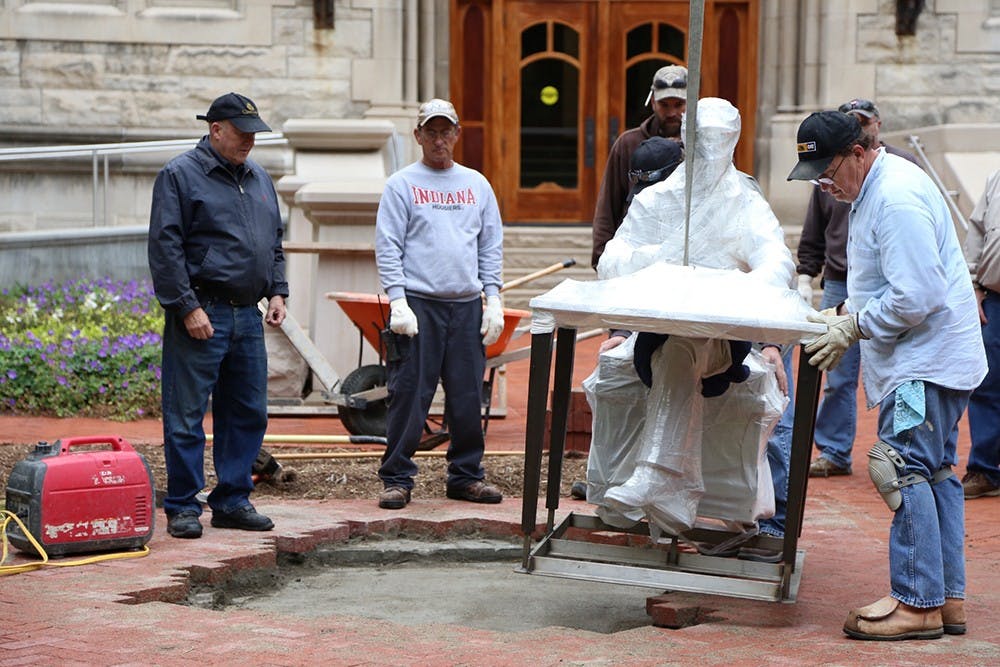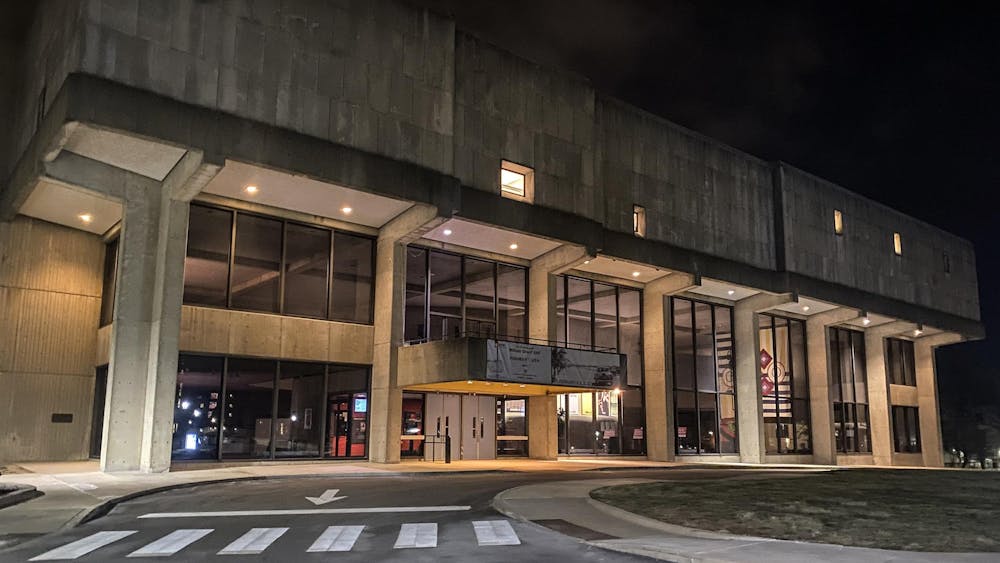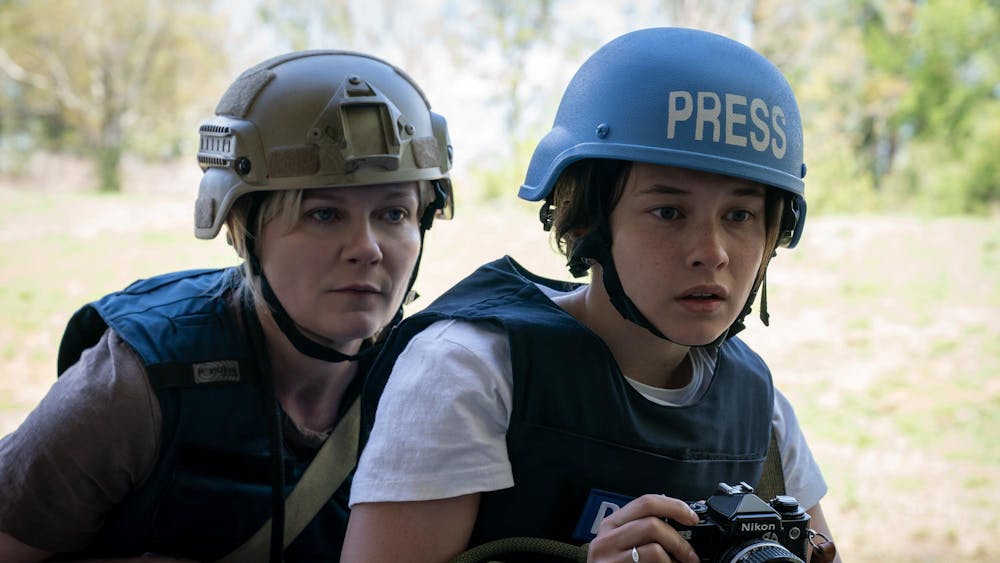He’s surrounded by years of his work, more than 300 models of sculptures that are placed around the country, some that he completed many years ago.
Herman B Wells sits atop a shelf above the door to the second room. His smile still the same and his hand outstretched.
Tuck Langland creates bronze sculptures ranging from two to 11 feet tall in a garage turned into a three-room studio.
It was here that he created the newest sculptural addition to the IU campus, Ernie Pyle, placed outside Franklin Hall, the soon-to-be-official home for the Media School.
***
Langland started sculpting in college.
Before college, he attended a boys military prep school in St. Paul, Minn., where he received no art training or education.
“Our headmaster said he didn’t believe in fads and frills like the arts,” Langland said. “I ?finished four years, never heard the word Rembrandt, anything like that. It was a completely closed world to me.”
He attended the University of Minnesota and, during the first quarter, took a woman on a date to the Minneapolis Art Institute. She knew all about the art, and he asked her how she knew so much.
She said that she had taken an art appreciation course.
The following quarter, Langland signed up for art ?appreciation.
“It was like a big door ?opening,” he said. “It was like a different world. I didn’t know that stuff was out there.”
In his sophomore year, he took drawing and design courses. In the first quarter of his junior year, he signed up for a sculpting class.
“I walked out the first day saying, ‘That’s it, I’m a sculptor,’” he said. “‘I know what I’m going to be all my life.’”
In that 12-week course, the students had to create a bust from a model. Langland said there were a lot of guys in the course from high-quality art high schools.
Despite their training, many of them struggled to finish the bust and had to pull all-nighters to complete the project.
“I finished six,” Langland said, laughing.
***
Langland went on to graduate school and studied sculpture.
He needed a job teaching sculpture in college, so he traveled to England to find one.
“We did an insane, stupid thing,” Langland said. “We bought tickets and sailed on a ship to England in the summer of 1964, looking for a college teaching job in sculpture in a foreign country, to start in September. And I got one.”
In 1971, he moved to South Bend and founded his studio.
Since then, Langland has created every sculpture in that studio, including that of Herman B Wells and the newest Ernie Pyle ?sculpture.
***
Installed last Thursday, and to be dedicated Friday afternoon, the Ernie Pyle sculpture started as a clay model a foot high.
With sculpting, it’s all about the fine details, Langland said. He measured Pyle’s typewriter, which is kept in Bloomington.
The lever on the end of the carriage that was used to move it back to the starting position and one line down did not work on Pyle’s typewriter.
Because of this, he had to move the lever manually, which is what he is doing with his typewriter in the sculpture.
The table Pyle sits at is warped and has cockeyed boards, which Langland added deliberately.
“I wanted it to look like it had sat out in a farmyard for a couple of years,” Langland said. “I didn’t want a nice, neat table.”
Langland, as for all of his sculptures, also has to think about the environmental factors of his outdoor pieces.
Most times, Langland pours water onto his clay mold to see how rain drains off of it. Allowing water to well up in his pieces would stain and damage the bronze, so Langland has to add drainage tubes to certain parts of each sculpture.
Langland worked on the details and molds of the Pyle sculpture from December 2013 to October of this year.
In his more than 50-year career, Langland has created dozens of these life-size sculptures, one of which sits on a bench just past the ?Sample Gates.
***
Langland sculpted IU’s eleventh president, Wells, in 2000.
“I also made him a little thinner than he was because he was pretty fat,” Langland said. “I didn’t want people to come by and say, ‘Who’s the fat guy?’ and just notice that.”
When Langland was asked to create the sculpture, it was an easy decision for him to take on the project.
“I like to do people that I respect,” he said. “I really respected him. He was a great man.”
Langland felt similarly about Pyle.
Ernie Pyle was an American journalist who is known for his coverage of WWII. He traveled to Europe, North Africa and Japan, covering the war from the trenches.
He was killed by sniper fire in 1945.
Langland developed respect for Pyle, especially after reading Pyle’s column about the Normandy invasion.
“It’s incredible,” Langland said. “It chills you to the bone. He observed, he saw, he listened. Those are the two greatest weapons for a reporter: looking and listening.”
The Pyle sculpture will join the ranks of what McRobbie calls, “the three iconic sculptures of IU,” ?Langland said.
Each sculpture allows students to participate in the piece. Students can sit with Herman B Wells, play the piano with Hoagy Carmichael and, now, type with Ernie Pyle.
“It’s the old story,” he said. “What can you do? If you can do something well, and you love doing it, there you are. I think a lot of people perhaps never quite figure that out.”






